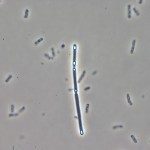Lien vers Pubmed [PMID] – 10589728
Microbiology (Reading, Engl.) 1999 Nov;145 ( Pt 11):3195-204
Crh of Bacillus subtilis exhibits 45% sequence identity when compared to histidine-containing protein (HPr), a phosphocarrier protein of the phosphoenolpyruvate (PEP):sugar phosphotransferase system (PTS). Crh can be phosphorylated by ATP at the regulatory Ser-46 and similar to P-Ser-HPr, P-Ser-Crh plays a role in carbon-catabolite repression. The sequence around the phosphorylatable Ser-46 in Crh exhibits strong similarity to the corresponding sequence of HPr of Gram-positive and a few Gram-negative bacteria. In contrast, the catalytic His-15, the site of PEP-dependent phosphorylation in HPr, is replaced with a glutamine in Crh. When Gln-15 was exchanged for a histidyl residue, in vitro PEP-dependent enzyme I-catalysed phosphorylation of the mutant Crh was observed. However, expression of the crhQ15H mutant allele did not restore growth of a ptsH deletion strain on the PTS sugars glucose, fructose or mannitol or on the non-PTS sugar glycerol. In contrast, Q15H mutant Crh could phosphorylate the transcriptional activator LevR as well as LevD, the enzyme IIA of the fructose-specific lev-PTS, which together with enzyme I, HPr and LevE forms the phosphorylation cascade regulating induction of the lev operon via LevR. As a consequence, the constitutive expression from the lev promoter observed in a (delta)ptsH strain became inducible with fructose when the crhQ15H allele was expressed in this strain.

